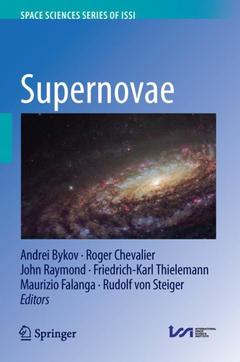Description
Supernovae, 1st ed. 2019
Space Sciences Series of ISSI Series, Vol. 68
Coordinators: Bykov Andrei, Roger Chevalier, Raymond John, Thielemann Friedrich-Karl, Falanga Maurizio, von Steiger Rudolf
Language: English
Subjects for Supernovae:
Publication date: 11-2018
452 p. · 15.5x23.5 cm · Hardback
452 p. · 15.5x23.5 cm · Hardback
Description
/li>Contents
/li>Biography
/li>Comment
/li>
From early Chinese astronomy to the most recent high precision, multi-wavelength observations, supernovae have been actively examined for centuries. In recent years, this intense study has yielded great insight into the physics of supernovae and their impact on a wide variety of subjects, from cosmology to astrobiology.
The unprecedented growth of observational information, the ever increasing computational power for modeling, and the deep multidisciplinary connections of supernovae to stellar physics, galactic evolution, astrochemistry, and cosmic ray origin motivated the publication of this contributed volume. The book provides insights on current progress in the field and presents open-ended questions for future supernova studies.
Originally published in Space Science Reviews in the Topical Collection "Supernovae"
Preface.- Type Ia Supernova Cosmology.- Crucial Physical Dependencies of the Core-Collapse Supernova Mechanism.- Single Degenerate Models for Type Ia Supernovae: Progenitor’s Evolution and Nucleosynthesis Yields.- Models for Type Ia Supernovae and Related Astrophysical Transients.- Neutrinos from Supernovae.- Superluminous Supernovae.- Peculiar Supernovae.- Circumstellar Interaction in Supernovae in Dense Environments—An Observational Perspective.- The Morphologies and Kinematics of Supernova Remnants.- Shock Waves in Supernova Ejecta.- Nucleosynthesis in Supernovae.- Dust in Supernovae and Supernova Remnants I: Formation Scenarios.- Dust in Supernovae and Supernova Remnants II: Processing and Survival.- Cosmic Ray Production in Supernovae.
Andrei Bykov is head of High Energy Astrophysics Division in the Ioffe Institute of Physics and Technology, Russian Academy of Sciences and Professor of St. Petersburg State Politechnical University. His principal research interest is theory and observations of physical processes in astrophysical objects with extreme energy release -- supernovae, pulsars, gamma-ray bursts and clusters of galaxies. He is the author and coauthor of over 200 scientific publications as well as the book Turbulence, Current Sheets and Shocks in Cosmic Plasma. He is the editor of five books on high energy astrophysics.
Roger Chevalier has been the W. H. Vanderbilt Professor of Astronomy at the University of Virginia since 1990. After obtaining his PhD from Princeton University in 1973, he joined the scientific staff of Kitt Peak National Observatory in Tucson, Arizona. He moved to the University of Virginia in 1979, where he was Astronomy Department chair from 1985 - 88 and 1989 - 92. His research has centered on theoretical studies of rapidly expanding astronomical sources, including supernovae, supernova remnants, gamma-ray bursts, pulsar wind nebulae, and galactic superwinds. Chevalier was chair of the science panel on Stars and Stellar Evolution for the 2010 astronomy decadal survey. His honors include Virginia's Outstanding Scientist Award (1991), the Dannie Heineman Prize for Astrophysics (1996), and election to the National Academy of Sciences (1996).
John Raymond is an astrophysicist at the Harvard-Smithsonian Center for Astrophysics in Cambridge, Massachusetts. His main scientific interests cover the fields of spectroscopy and physics of the solar corona, the physics and spectroscopy of collisionless shock waves in supernova remnants and the physics of winds from accretion disks on X-ray emitting binaries.
Friedri
Written by world-leading researchers in the field of supernovae
Provides the most updated collection of results on supernovae and related phenomena
Demonstrates how new revelations in supernova physics impact other disciplines across the spectrum
© 2024 LAVOISIER S.A.S.
These books may interest you

Allen’s Astrophysical Quantities 242.64 €

Star Formation 137.14 €

Star Formation 137.14 €

